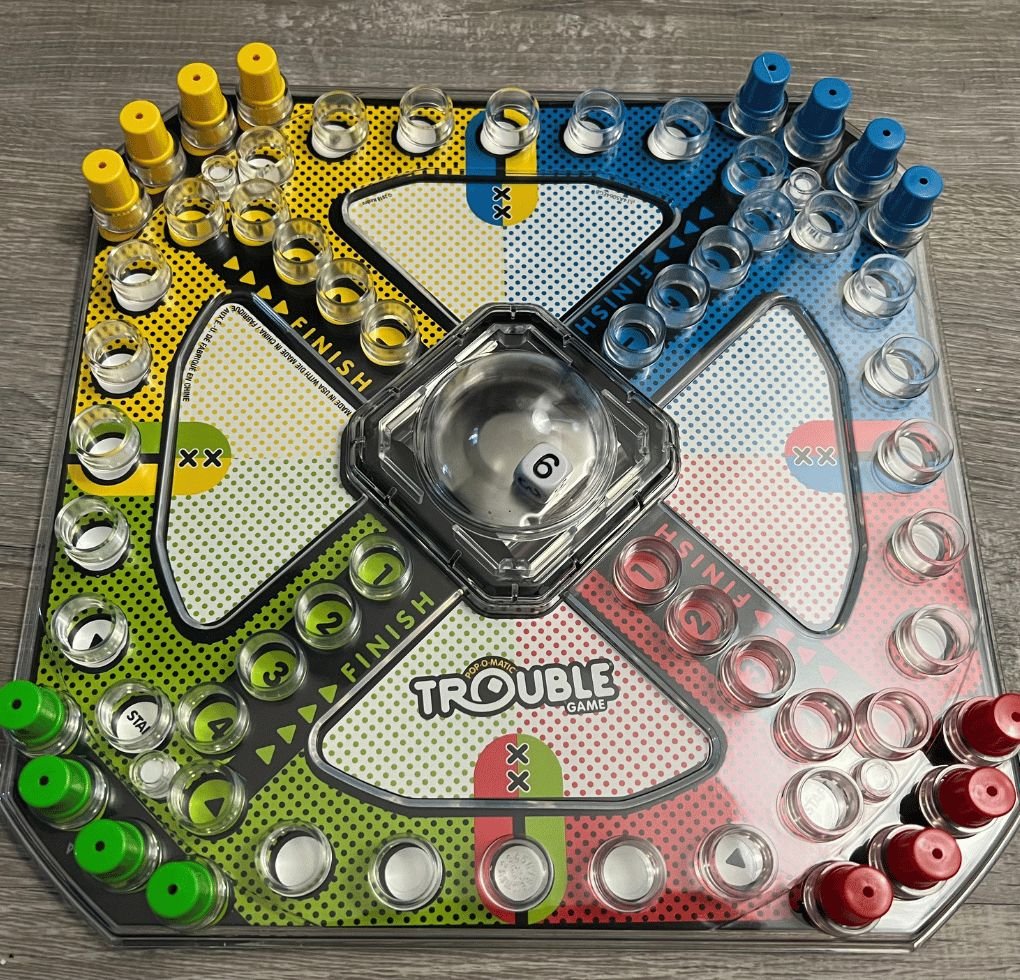If you're looking for a classic board game to enjoy during your fun family game night, Trouble is an excellent choice.
This game is designed for two to four players and provides hours of entertainment.
Below you will find the video tutorial and written explanation of the Trouble game rules.
Trouble Tutorial
Needed
Two to four players; the Trouble board game with the Pop-O-Matic dice roller and 16 pegs (four sets of colored pegs)
Setup
Place the Trouble game board in the middle of the playing area.
Each player will move their own pegs to their starting position. Players will choose a different color set of pegs to play. The selected pegs are place into the home space of the matching color.
Objective
The object of the game is simple: be the first player to get all four of your game pieces into your finish zone.
However, there is a catch - your game pieces must navigate around the game board clockwise before they can enter the finish zone.
Game Play
Once you have set up the game, it's time to get started. The youngest player gets the first turn.
Here is how a turn works:
Roll the Die: The player whose turn it is presses the Pop-o-Matic die roller. The number rolled determines your move.
Move Your Peg: Depending on the number rolled:
1: If you roll a 1, all other players must move one of their pegs out of their home base and into their start space.
2, 3, 4, or 5: You can move any one of your own pegs the indicated number of spaces if the peg is already on the playing track.
6: Rolling a 6 gives you options. You can either move one of your own pegs from home to your start space or move one of your own pegs on the playing track 6 spaces.
If a player makes a roll with the Pop-O-Matic die roller, but can't make a valid move, the player's turn is over.
For example, if Blue rolls a 3 but doesn't have a peg on the track, they can't make a move.
The game continues clockwise left to the next player for the next turn. The players continue to taking turns, rolling, and moving when possible.
Winning
To win Trouble, you need to be strategic in your moves and aim to get all four of your pegs into the finish zone. The first player with all four of their pegs in the finish zone wins the game!
A player does not need an exact count to enter the finish zone; simply roll and move until you reach a finish space.
Once you have rolled enough to enter the finish zone, place your peg into the open finish space closest to the center of the board.
Rules of the Game
To keep the game fair and fun, there are a few important rules to remember:
Sending Opponents Back: If a player lands on a space occupied by an opponent, the opponent's peg is sent back to their home space.
Blocked Start: If your start space is occupied by one of your own pegs, you can't start a new peg from your home space.
Rolling Again: Rolling a 6 gives you the opportunity to roll again. Additionally, if you land on a double trouble space on the board, you get to roll again. However, two rolls are the maximum allowed in one turn. If you've already rolled twice, getting a 6 or landing on a double trouble space will not result in another roll.
Trouble one of the classic board games that is perfect for family game night.
It combines elements of luck and strategy, making it enjoyable for players of all ages, including young children.
So, gather your family and friends, set up the Trouble game board, and have a blast trying to be the first to get your four pegs into the finish zone.
May the highest number rolls and clever moves lead you to victory in this exciting and timeless board game.
Newer Versions of Trouble
While the classic version of Trouble has been covered, it is worth mentioning that there have been newer iterations of the game with slight variations in rules and themes.
These versions might introduce additional elements like power-ups, special abilities for your pegs or a specialized board.
If you're playing a different version of Trouble, be sure to familiarize yourself with the specific Trouble game rules and object of the game for that version.
However, the classic game, as described in this article, remains a timeless and enjoyable choice for a family game night.
DISCLAIMER: This page contains affiliate links, which means that if you click on one of the product links, I’ll receive a small commission at no extra cost to you. Thank you for your support!


